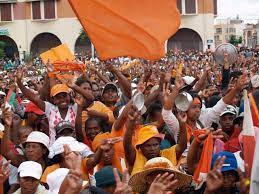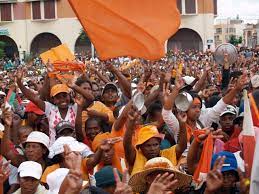Herein this post, we discussed the early history of Madagascar and furthermore the Independence, politics and the political history of Madagascar.
EARLY HISTORY
The history of Madagascar is distinguished clearly by the early isolation of the landmass from the ancient supercontinent of Pangaea, containing amongst others the African continent and the Indian subcontinent, and by the island’s late colonization by human settlers from the Sunda Islands (Malay Archipelago) and from East Africa. These two factors facilitated the evolution and survival of thousands of endemic plant and animal species, some of which have gone extinct or are currently threatened with extinction. Trade in the Indian Ocean at the time of first colonization of Madagascar was dominated by Indonesian ships, probably of Borobudur ship and K’un-lun po types.
Read: POLITICAL HISTORY OF MOROCCO
Over the past two thousand years the island has received waves of settlers of diverse origins including Austronesian, Bantu, Arab, South Asian, Chinese, and European. The majority of the population of Madagascar today is a mixture of Austronesian and Bantu settlers. Despite popular belief, there has been no genetic input from Arabs or Indians, although one tribe, the Antemoro, claims descent from Somali Arab traders. European and Middle Eastern paternal ancestry is also present.
INDEPENDENCE
First Republic (1960–1972)
Tsiranana’s rule represented continuation, with French settlers (or colons) still in positions of power. Unlike many of France’s former colonies, the Malagasy Republic strongly resisted movements towards communism.
In 1972, protests against these policies came to a head and Tsiranana had to step down. He handed power to General Gabriel Ramanantsoa of the army and his provisional government. This régime reversed previous policy in favor of closer ties with the Soviet Union.
On 5 February 1975, Colonel Richard Ratsimandrava became the President of Madagascar. After six days as head of the country, he died in an assassination while driving from the presidential palace to his home. Political power passed to Gilles Andriamahazo.
Second Republic (1972–1991)
On 15 June 1975, Lieutenant-Commander Didier Ratsiraka (who had previously served as foreign minister) came to power in a coup. Elected president for a seven-year term, Ratsiraka moved further towards socialism, nationalizing much of the economy and cutting all ties with France. These policies hastened the decline in the Madagascan economy that had begun after independence as French immigrants left the country, leaving a shortage of skills and technology behind. Ratsiraka’s original seven-year term as president continued after his party (Avant-garde de la Révolution Malgache or AREMA) became the only legal party in the 1977 elections.
In the 1980s, Madagascar moved back towards France, abandoning many of its communist-inspired policies in favor of a market economy, though Ratsiraka still kept hold of power.
Eventually, opposition, both within and without, forced Ratsiraka to consider his position and in 1992 the country adopted a new and democratic constitution.
Third Republic (1991–2002)
The first multi-party elections came in 1993, with Albert Zafy defeating Ratsiraka. Despite being a strong proponent of a liberal, free-market economy, Zafy ran on a ticket critical of the International Monetary Fund (IMF) and the World Bank. During his presidency the country struggled to implement IMF and World Bank guidelines that were, on the short term, suicidal politically.
As president Zafy was frustrated by the restraints placed upon the powers of his office by the new constitution. His quest for increased executive power put him on a collision course with the parliament led by then Prime Minister Francisque Ravony. Zafy eventually won the power he sought after but suffered impeachment at the hands of the disenfranchised parliament in 1996 for violating the constitution by refusing to promulgate specific laws.
The ensuing elections saw a turnout of less than 50% and unexpectedly resulted in the re-election of Didier Ratsiraka. He moved further towards capitalism. The influence of the IMF and the World Bank led to widespread privatization.
Opposition to Ratsiraka began to grow again. Opposition parties boycotted provincial elections in 2000, and the 2001 presidential election produced more controversy. The opposition candidate Marc Ravalomanana claimed victory after the first round (in December) but the incumbent rejected this position. In early 2002 supporters of the two sides took to the streets and violent clashes took place. Ravalomanana claimed that fraud had occurred in the polls. After an April recount the High Constitutional Court declared Ravalomanana president. Ratsiraka continued to dispute the result but his opponent gained international recognition and Ratsiraka had to go into exile in France, though forces loyal to him continued activities in Madagascar.
POLITICS OF MADAGASCAR
Politics of Madagascar takes place in a framework of a semi-presidential representative democratic republic, whereby the President of Madagascar is head of state and the Prime Minister of Madagascar is head of government, and of a pluriform multi-party system. Executive power is exercised by the government. Legislative power is vested in both the government and the Senate and the National Assembly. The Judiciary is independent of the executive and the legislature.
POLITICAL HISTORY
Madagascar’s first President, Philibert Tsiranana, was elected when his Social Democratic Party gained power at independence in 1960 and was reelected without opposition in March 1972. However, he resigned only 2 months later in response to massive anti-government demonstrations. The unrest continued, and Tsiranana’s successor, Gen. Gabriel Ramanantsoa, resigned on February 5, 1975, handing over executive power to Lt. Col. Richard Ratsimandrava, who was assassinated 6 days later. A provisional military directorate then ruled until a new government was formed in June 1975, under Didier Ratsiraka. During the 16 subsequent years of President Ratsiraka’s rule, Madagascar continued under a government committed to revolutionary socialism based on the 1975 Constitution establishing a highly centralized state. National elections in 1982 and 1989 returned Ratsiraka for a second and third 7-year presidential term. For much of this period, only limited and restrained political opposition was tolerated, with no direct criticism of the president permitted in the press.
Read: POLITICAL HISTORY OF SOUTH AFRICA
Presidential elections were held on November 25, 1992, after the High Constitutional Court had ruled, over Hery Velona objections, that Ratsiraka could become a candidate. Runoff elections were held in February 1993, and the leader of the Hery Velona movement, Albert Zafy, defeated Ratsiraka. Zafy was sworn in as President on March 27, 1993. After President Zafy’s impeachment by the National Assembly in 1996 and the short quasi-presidency of Norbert Ratsirahonana, the 1997 elections once again pitted Zafy and Ratsiraka, with Ratsiraka this time emerging victorious. A National Assembly dominated by members of President Ratsiraka’a political party AREMA subsequently passed the 1998 Constitution, which considerably strengthened the presidency.
In December 2001, a presidential election was held in which both major candidates claimed victory. The Ministry of the Interior declared incumbent Ratsiraka of the AREMA party victorious. Marc Ravalomanana contested the results and claimed victory. A political crisis followed in which Ratsiraka supporters cut major transport routes from the primary port city to the capital city, a stronghold of Ravalomanana support. Sporadic violence and considerable economic disruption continued until July 2002 when Ratsiraka and several of his prominent supporters fled to exile in France. In addition to political differences, ethnic differences played a role in the crisis and continue to play a role in politics. Ratsiraka is from the coastal Betsimisaraka tribe and Ravalomanana comes from the highland Merina tribe.
Following the crisis of 2002, the President replaced provincial governors with appointed PDSs (Presidents des Delegations Speciales). Subsequent legislation established a structure of 22 regions to decentralize administration. In September 2004, the Government named 22 Regional Chiefs, reporting directly to the President, to implement its decentralization plans. Financing and specific powers for the regional administrations remain to be clarified.

After being re-elected in 2006, Ravalomanana’s government was dissolved in March 2009, in a militarily-backed uprising led by Andry Rajoelina. Rajoelina formed a High Transitional Authority of which he was the ‘Transitional Head of State’. So far he has held a referendum, in November 2010, to update the constitution. Despite an alleged coup during, this was approved, and new elections were scheduled to be held in July 2013.
The second round of the postponed presidential elections was held in December 2013 and the results were announced in January 2014. The winner and the next president was Hery Rajaonarimampianina. He was backed by Rajoelina who led the 2009 coup and still was very influential political figure.
In 2018 the first round of the presidential election was held on 7 November and the second round was held on 10 December. Three former presidents and the most recent president were the main candidates of the elections. Former president Andry Rajoelina won the second round of the elections. He was previously president from 2009 to 2014. Former president Marc Ravalomana lost the second round and he did not accept the results because of allegations of fraud. Ravalomana was president from 2002 to 2009. The most recent president Hery Rajaonarimampianina received very modest support in the first round. In January 2019 the High Constitutional Court declared Rajoelina as the winner of the elections and the new president. In June 2019 parliamentary elections the party of president Andry Rajoelina won absolute majority of the seats of the National Assembly. It received 84 seats and the supporters of former president Ravalomana got only 16 seats of 151 seats of the National Assembly. 51 seats of deputies were independent or represented small parties. President Rajoelina could rule as a strongman.


